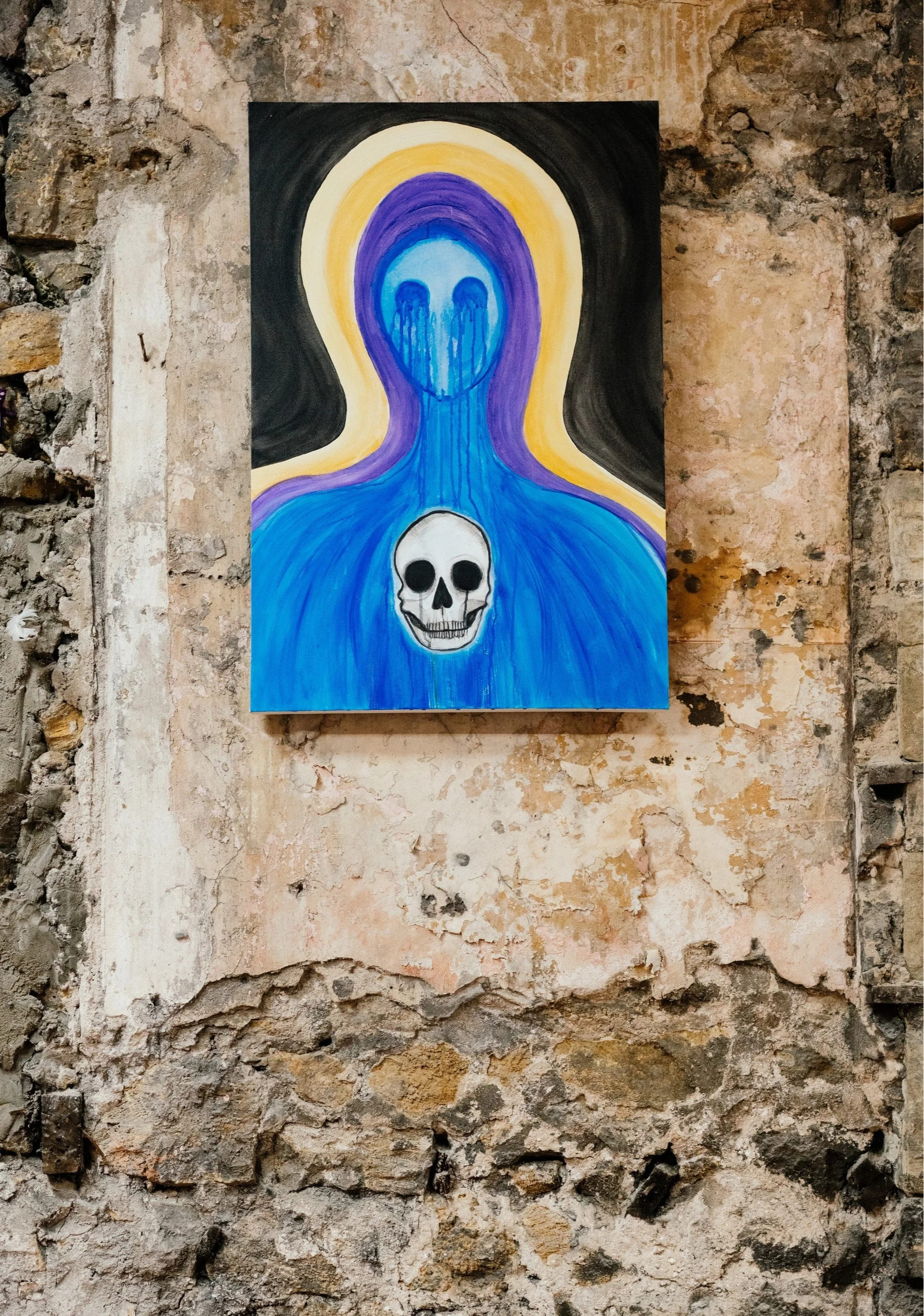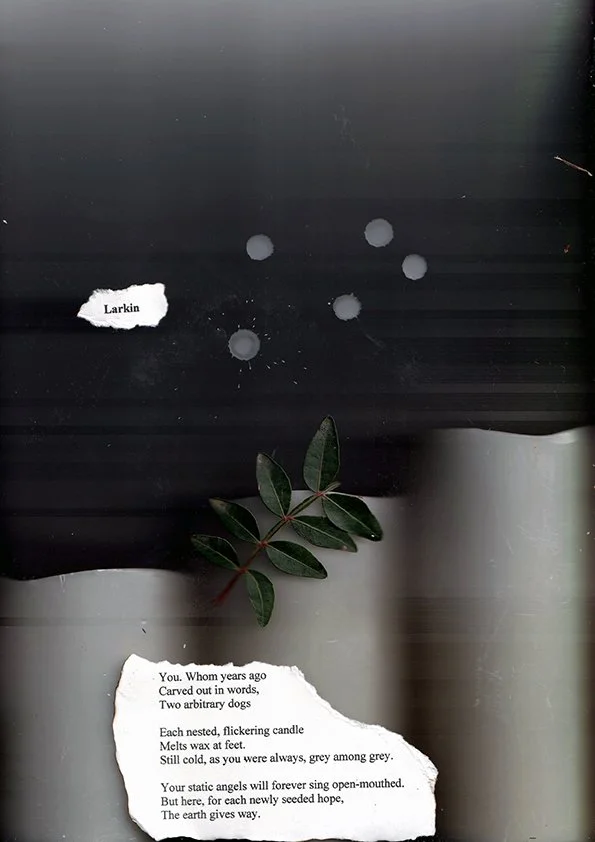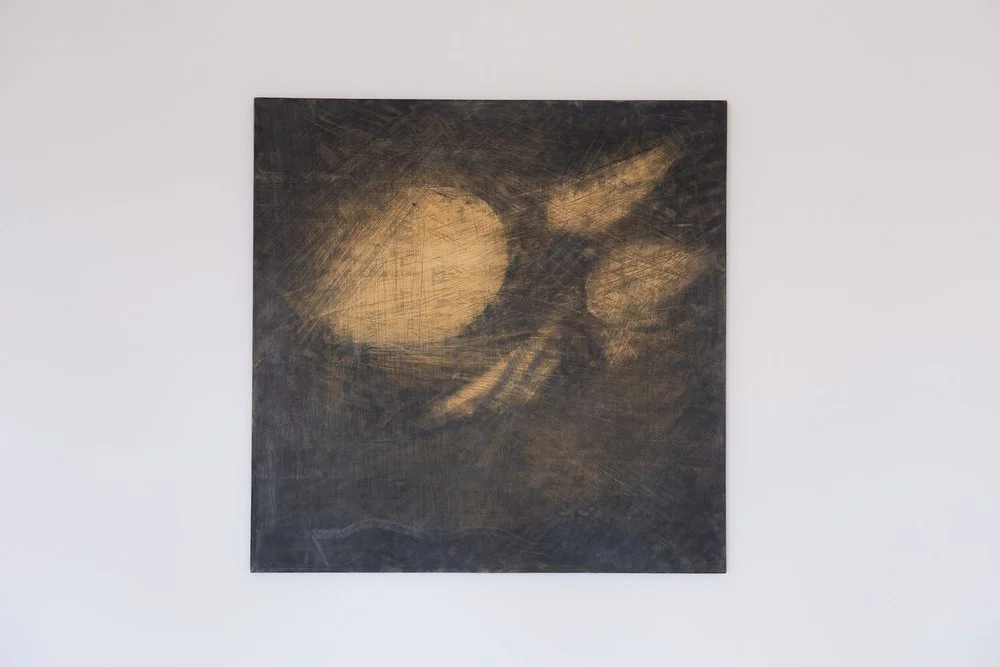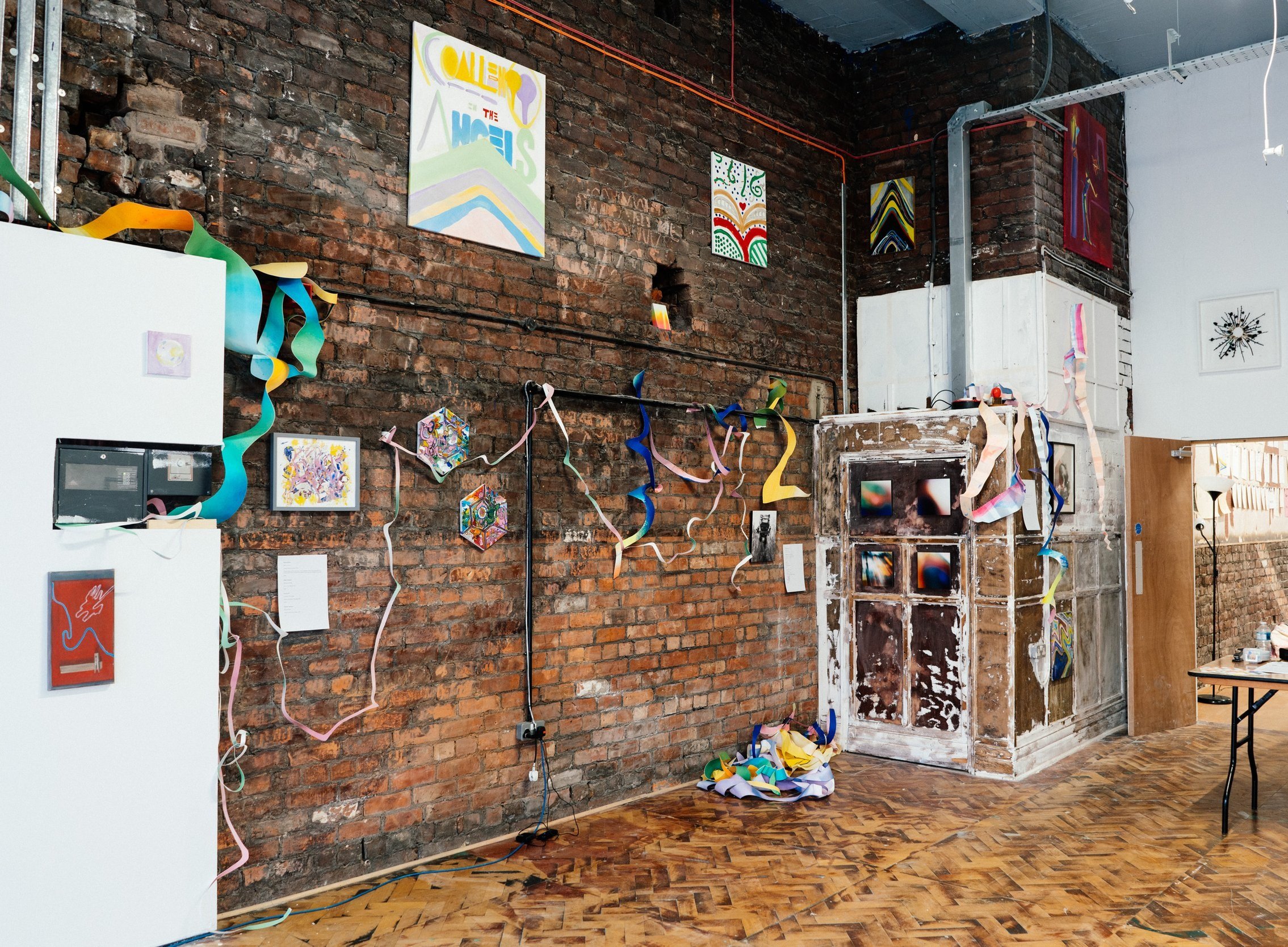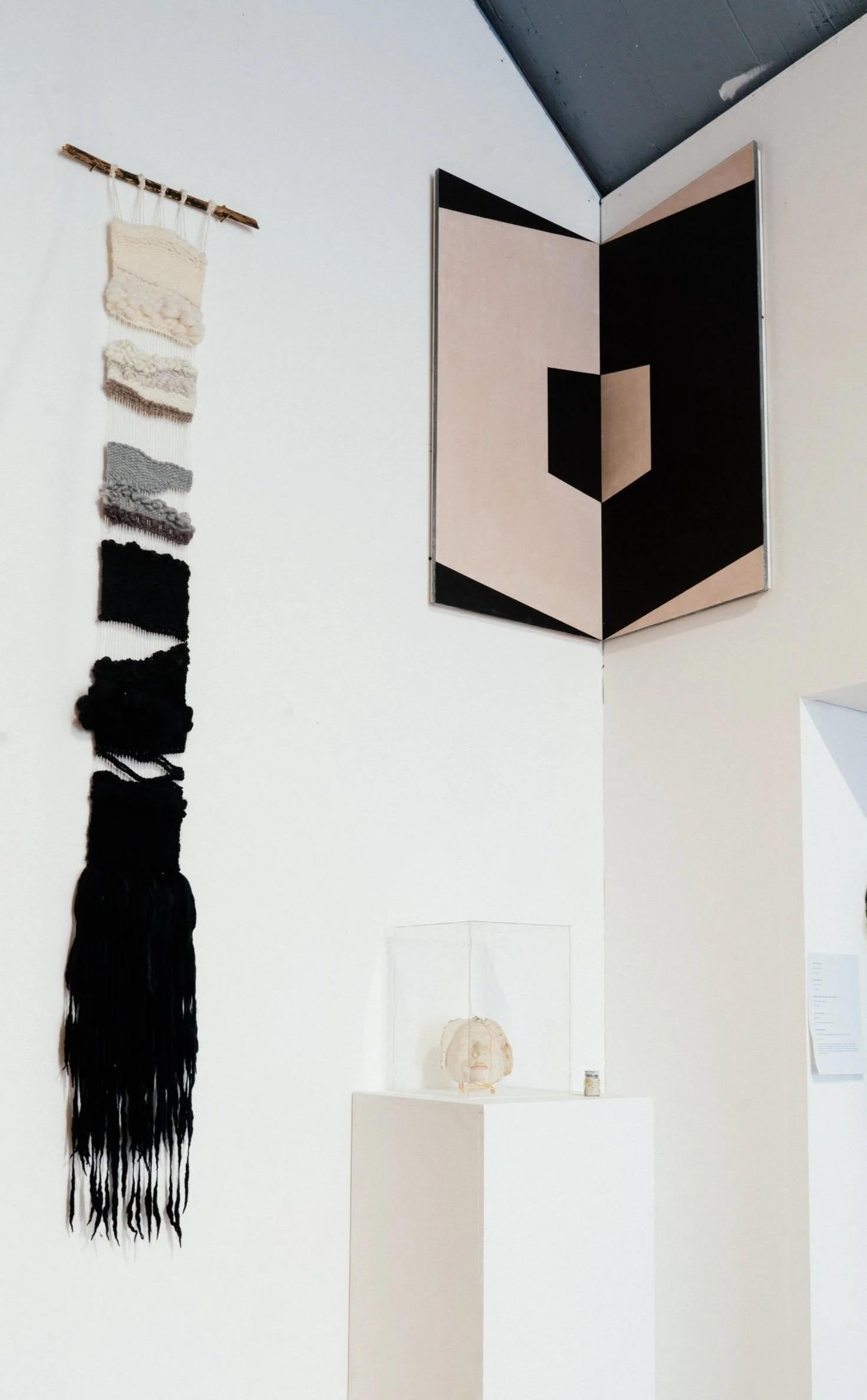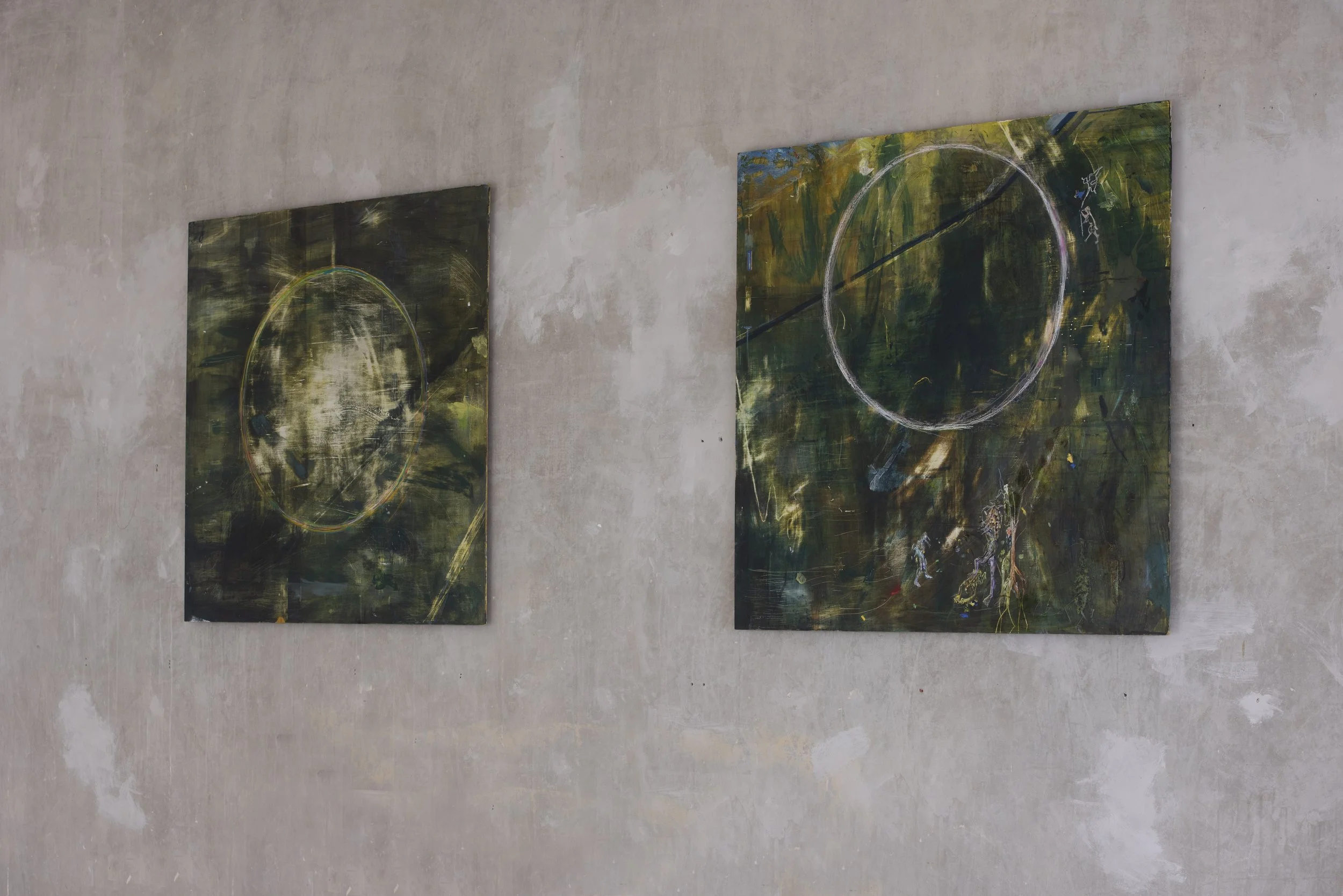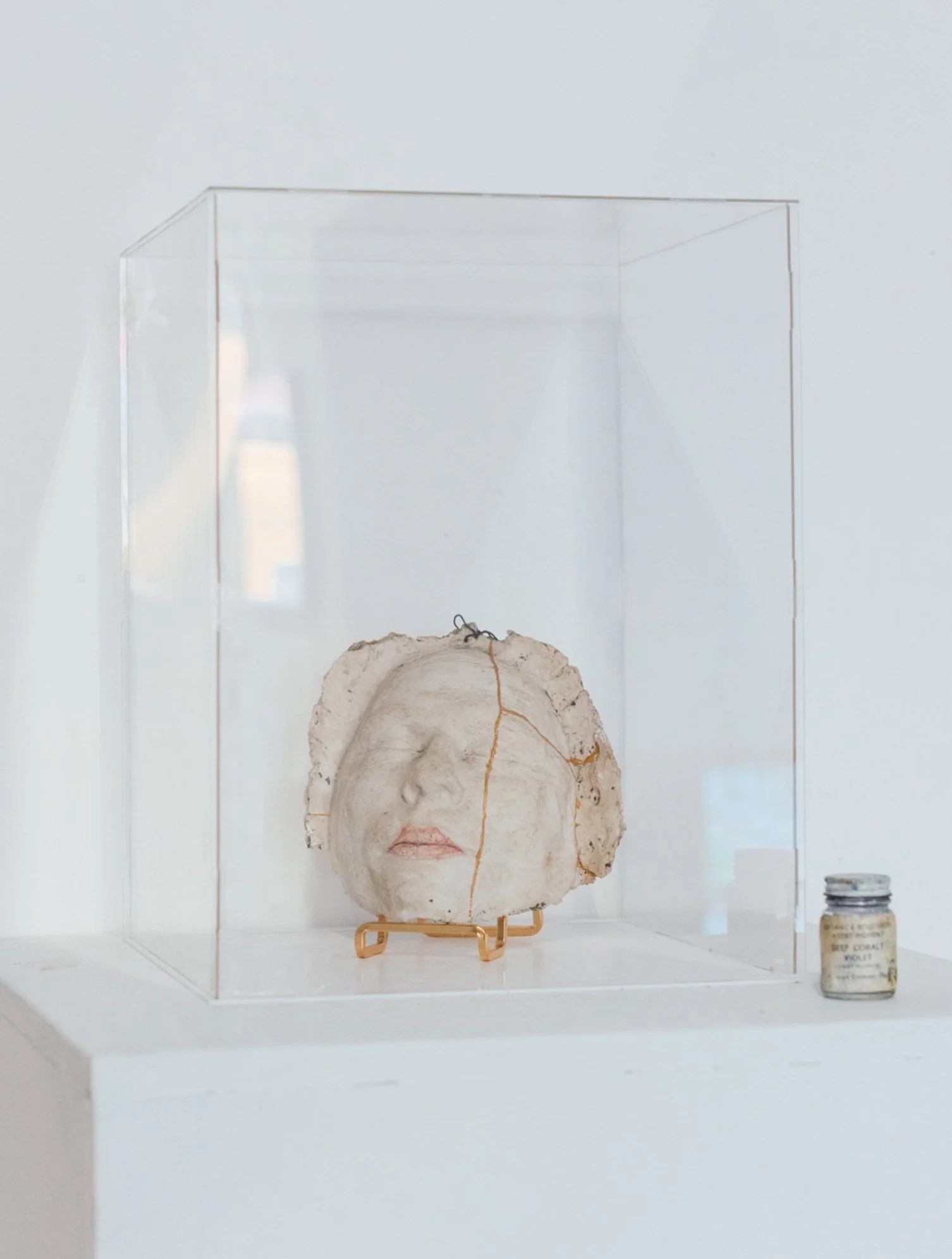Once Upon A Time There Was An Exhibition
Introduction
This piece is about an exhibition that I curated in 2023 at the Moving Gallery, Sunderland. The exhibition showcased the work of 50 artists who responded to the question, ‘What Does Life After Death Look Like?’
After my Mum took her life, the grief was so all encompassing that I got to know how she felt. I used art to help process these feelings. When I found out my Dad had terminal cancer, I was like, *&%£s*, stop, hold on… I'm going to need a creative project. That project began in 2020, with me initiating my own Master's Degree in Fine Art (DIY MFA), and led on to this exhibition.
I knew I wasn't the only one grieving and grappling with concerns of their own mortality, I knew how art had helped me, and I wanted to somehow find a way of inviting other people into a cathartic creative process.
I am grateful to have had the opportunity to work with all of the artists involved and to curate this exhibition. The exhibition and this online catalogue are celebrations of a beautiful coming together of diverse perspectives and artworks responding to the question of life after death.
Creating this piece of writing, containing such a variety of creative expressions has been a wonderful learning experience for me, and I very much hope that I've done the artists’ work justice
A note for the reader
Each mention of an artist or artwork in the exhibition is also a clickable hyperlink to the artist’s page on the Life After Death Catalogue, where you can see their work and find out more about the artist.
Instagram links - click once to play video, click twice to view the work on instagram.
The hyperlinks to the artist pages will look like this: The Pigeon. The links will open in a new page.
Fig.1. ‘Multidimensional Self’
Once Upon A Time There Was A Question
The question, ‘What Does Life After Death Look Like?’ is ultimately unanswerable, however, the artists in this exhibition have shown us that in many different ways, some truth of the answer is expressible. So, without further ado, once upon a time there was a question posed.
The truth of the matter has been put down to the moon, although the soul seems to know, deep within its cocoon, that the moon is a reflection of something deep inside and it's from there that we ask the question, what does life after death look like?
From Alisia Anne's expressions of ghostic encounters (Fig.3) to Roberta Green's ‘Multidimensional Self’, this exhibition explored the not quite visible spaces where the intangible movements of life after death glimmer a quantum dance.
Albie Auchterlounie's ‘Concrete Jungle’ (Fig.2) sat in the window with a startling yet still presence. Archaic. I wondered if this driftwooden being was making efforts to communicate. The materials seemed to emanate lost information, perhaps from the ancestors. Now and again I’d see the static rising from its antenna. I wondered if our ancestors walk amongst us now, like barely perceptible holograms of the heart?
In the front space, a tarot card pulled by a baby and ‘Doofa Doll’ (Fig.4) a benevolent being made of Ash tree and red thread, who held a silver witch. In the back space, ‘The Virgin, The Warrior, The Goddess’ (Fig.5) Katie Pickerell’s expressions of motherhood appeared like deities. Accompanied by a feather, a painting of mine, ‘Awakening The Divine Mother’ (Fig.5) and a painting by Roberta Green, ‘Multidimensional Self’ (Fig.1).
Fig.2 ‘Concrete Jungle’ by Albie Auchterlounie
Rolling film works softly suffused the auditory space. Words of truth and hope interlaced and overlapped the crashing of waves and sound of birdsong. Svetlana Atlavina (Fig.7) whispered quiet candours to a chorus of angelic hums, “...memories of childhood…nothing will ever be the same…” and Hannah Campion reflected on her near death experience, “...I feel selfish, lucky and confounded, surviving and cheating death shouldn't leave me so dumbfounded.” in her film-poem, ‘Being Seen’.
Anonymous X glimpsed God, while choking close to death under a bed, Chris Robinson (Fig.9) found peace on a motorcycle, he said, and ‘From The Heart’ Margaret Baity wrote, “Thank you.” (Fig.6).
In my experience, it can feel scary and even embarrassing to share artworks, especially when they come from a tender place within. In the right environment however, it can be an empowering act. Hung on the washing line a drawing read, ‘I Am Grateful for The Humiliation of Being Seen’. (Fig.8.)
Zehra Fatima's poem, ‘Sculptures of Strength, Power and Courage’, expressed words of resilience; “Little does the sea know that no amount of storms can break these rocks, now they are independent of the sea that once tormented them.” (Fig.11.)
Words like seeds being watered.
“...your static angels will forever sing open mouthed. But here, for each newly seeded hope, the earth gives way.” (Fig.10.)
Fig.7. Extract of ‘Beyond the Physical Border there is Eternity in the Physical World’ by Svetlana Atlavina
Fig.6. ‘From The Heart’, by Margaret Baity
Fig.11.
Fig.12. 'Portrait in the third trimester’ by Jasmin Spires
Connection
In his book ‘The Creative Act’, Rick Rubin writes, "One reason art resonates is because human beings are so similar. We're attracted to the shared experience held within the work. We recognise some part of ourselves and feel understood. And connected."
Connecting with expressions of grief, through music, reading and art has certainly helped me to feel less like an abandoned island floating through space.
Death and Rebirth
Art can become a welcome vehicle for navigating the most tricky and existential of subjects. Jasmin Spires’s 'Portrait in the third trimester’ (Fig.12) stood like Goddess Devi. Splits in consciousness and time led the artist to meditative practices to support her through the death of one reality and birth of another.
Brad Race’s ‘Burning Passions’ (Fig.13) hung orange like a channel between the living and the deceased. Mirrored in space by an ink work; ‘Just You and I Know That You Never Died Nor Were You Ever Born.’ (Fig.14.)
Death can come in many forms of ending. It may come in the form of the death of a person or of a relationship, the death of a way of life or the death of a way of seeing.
The late Anthony Whitfield’s painting, ‘In The Womb (Death and Rebirth)’ hung opposite and above. Soon before his death he reflected; “All I could hear was my own breath and heartbeat, it was like being in the womb… I felt a strange relief. The shapes in the painting are the remembered light that resonated in my mind after the light was diminished by layers of scrim tape. Hours later, a knock on the head, you're set! And I was broken out into the light, it was like being re-born!” (Fig.15)
I wonder if that’s how he feels now? Like a glistening black void in the wall, Hannah Brown’s ‘Stardust’ reminds us from where we came and to where we may well return. (Fig.16.)
Is Death Really Where It All Ends?
Hannah Campion's flowing ribbon paintings struck like the flow of life energy, animating the spaces in between artworks (Fig.17). The birdsong in Trayner/Dyson’s film, ‘After The Rain’ (Fig.18) sang the song of safety and Svetlana Atlavina's film, ‘Beyond the Physical Border there is Eternity in the Physical World’ (Fig.7) offers the suggestion that it does indeed, not end here.
Nevertheless, grief continues to be a challenging human experience. It could cause us to feel like a ‘Lonely Robot’ (Fig.19). It could cause us to glimpse the interconnectedness of all of life, or notice a shared centre of our being, as pointed to by Samantha Goodlet in her painting, ‘Concentric’. (Fig.20.)
It could make us feel ‘Like Going To Sleep’. It could cause us to create something new. “What Does Your Soul Say?” (Fig.21) asked one of the papers on the washing line. "It is Wise To Trust Your Intuition” (Fig.22) said another, and another, “DIY MFA: A Rehabilitation/ Transformation Process.”
Fig.17. An aspect of a multimedia performance entitled 'Rainbow x Magnation II The Athenaeum'. Painting aspect by Hannah Campion.
Fig.18. Extract of ‘After The Rain’, by Trayner/Dyson

Fig.21. 'What Does Your Soul Say?' by Amy South

Fig.20. ‘Concentric’ by Samantha Goodlet

Fig.22. 'It is Wise To Trust Your Intuition' by Amy South

Fig.19. ‘Lonely Robot’ by Aly Smith
Fig.23. ‘Exquisite Corpse’ by Elizabeth Black
Transformation
On the subject of transformation, spiritual teacher Eckhart Tolle writes, “You cannot transform yourself, and you certainly cannot transform anybody else. All you can do is create a space for transformation to happen, for grace and love to enter.” I think that the artistic process can become a space like this, a creative grace space.
Elizabeth Black's wall hanging and ‘Weave Your Own’ workshop embodied the transformative potential of the creative process. The woven and crossed over fabrics of ‘Exquisite Corpse’ (Fig.23) hung tall, and reached down far below. Its body, evidence of hundreds of moments, spent breathing new life into fabrics that would otherwise have been discarded, a process that Elizabeth shared with workshop participants during the exhibition. A participant recalls, “The environment allowed us to share experiences of grief and loss whilst working on our own weave outcome.”
Records and reflections of loved ones, lost, appeared throughout the exhibition. My Mother and many others quietly willed us on In Spirit∞. Kasia Parker notes, "This is the most personal artwork I've ever made, and creating helped me process the feelings of loss and grief.” (Fig.24.)
David Foggo's painted poetics, “Bucket List, Get Buried, Rot” (Fig.25) satirically pointed out the cycle of life and David Sproxton created a pot using the ashes of a previous form (Fig.26). Zoë Parker Smissen’s 'Gilded Charred Circle’ “...combines naturally found materials as a metaphor to the beautifully precious cycle of life: Trauma, death, rebuilding [and] rebirth… finally reaching a celebration of new beginnings. (Fig.27.)
A Shift In Perspective
Reflecting on these works reminds me of the ongoing nature of life. When a person or situation is lost, all may not be lost, although it can feel that way.
Founded by artist Karen Underhill, who tragically lost her husband during lockdown, ‘Beyond The Waves’ is a post-covid grief and art support group, working with people who lost loved ones during the pandemic.
Karen reflects on the work being done: “We have been creating works of remembrance. They have allowed for healing and connection following loss. They are authentic and heartfelt… They pay tribute to the power of traumatic growth through art and connection. The participants continue to thrive, grow and to help each other. This is what life looks like after death.” Margaret Baity, a member of the group, exhibited her poem ‘From the Heart’. (Fig.6.)
An Invitation
“Art is our portal to the unseen world." - Rick Rubin
Each artwork is an invitation into a new way of seeing, into another's inner world; an expression of the invisible encounter.
Melissa Duncan's painting, 'Hatter’s Plush' (Fig.28) explores access points to alternate dimensions of reality, inspired by Alice's somewhat psychedelic journey into Wonderland. Karen Sikora’s painting ‘After She Left’ (Fig.29) offered us an entrance that, when gazed into, began to reveal rich scenes. A sense of spaciousness and imagination arose as I took steps into the painting, moving aside leaves and branches to reveal a hidden and living depth.
Perhaps this sense was something akin to that which stood through the doorway of ‘Corner Painting’ by Anthony Whitfield (Fig.30). An optical illusion that shifted visual perception, inviting us to experience what we choose to see. Was it a doorway into darkness or a doorway into light? It was both, held together in one form, like yinyang, like life and death. As I focused on the doorway into darkness, it actualized. This reminded me of the phrase: ‘What you focus on expands.’
Katie Pickerell’s ‘Dream Manifestation Workshop’ (Fig.31) invited us to focus on gratitude, “Grounded in gratitude we will meditate and visualise our dreams as if they already exist, focusing not just on the object of our desires but the feelings that they bring us.”
Fig.28. ‘Hatter’s Plush’ by Melissa Duncan
Fig.29. ‘After She Left’ by Karen Sikora
Fig.32. ‘Life After Death’ by Andrew Mccoy
Fig.33. An extract of ‘The Dance Of The Seven Veils’ by Rev. Pamela Joy Giese
Activity
It was great to have activities happening in the space, from workshops to participatory performances, the presence of people and energy brought the exhibition to life.
Kev Howard’s didgeridoo “protest rhythms” transformed the frustrations of inequality into a fiery performance for positive change, carving out in sound, a more equal, joyful future in his work ‘The Black Triangle’
Through the creation of books, poetry and website content, DID We Write are raising awareness about Dissociative Identity Disorder. They aim to dispel misconceptions about DID and give voice to different ways of seeing.
In his workshop, ‘Awareness in Space’, performer and voice coach Matt Cummins invited us to explore our inner spaces, as well as “...the immediate outer, and the wider space of the exhibition and its contents. Through the breath, the body, movement and stillness we hope to help to move you somewhere new, and from there to be and view."
All We Want Is Breath
“All we want is breath…” to speak out, like Andrew Mccoy so captivatingly did in his performance of ‘Life After Death' (Fig.32) “I am a monument, to what confides in us, what trusts us to live” and like Elizabeth Black did in her awakening performance, ‘Regret’, “I know their secret, they are here to remind me…”
Howard Hannah’s multimedia work, ‘Rainbow x Magnation II The Athenaeum’ immersed the audience in a pool of shifting light and the vibration of throat singing. Held in the comforting space of Hannah’s flowing ribbon paintings, I felt an inner cleansing of the dust unsettled by the grieving process.
Rev. Pamela Joy Giese’s ritual, ‘The Dance Of The Seven Veils’ had the audience chanting the sound of the seven central chakra points, guided in note by Zassō Fūkei on the harmonium. This, together with the dancers, who were adorned with and later relieved of seven colourful veils, created the environment to take us on a journey to the soul. Pamela writes: “This dance is an initiation in the way that all initiations involve a death to the old self and a rebirth to the new.” (Fig.33, 35 & 36.)
Hannah Campion’s draped and dreamy rainbow, ‘Painting XIII’ (Fig.34) played backdrop to Zassō Fūkei’s ‘Paradise Action II: Westing’. Words read from The Book of Chuang Tzu blurred into a mesmeric atmosphere of reverberating sound and layers of spacious rhythms that seemed to transport the exhibition somewhere else.
Sometimes we just need the space to breathe, as we were afforded the opportunity with Karen Sikora’s work, ‘The Experiment - Wait/Look/Listen’. Dreamlike, this performance invited the audience to participate in 15 minutes of silence, at the end of an action packed-opening night.
Fig.37. ‘End Point’ by Andrew Crane
Challenge
Sometimes art can be challenging, as seen in a response to Andrew Crane's painting, ‘End Point’ (Fig.37). “A criticism of Arthood's incestuously familiar ambiguity.” was the title of a post made by a critic of the exhibition. The critic began, “To ask what life after death looks like, you need to ask someone who is dead.” He continues, “... [or else] you end up with the utter nonsense of a show being called whatever first pops into your head and plus work to match.” I was interested in where this conversation would go. Click here for the full exchange.
The title question for the exhibition did just pop into my head, during a conversation with a frozen pigeon, who responded in ambiguous certainty.
Sometimes art arrives as an idea that disrupts the way we usually look at something. Laura Roberts exhibited the concept of a ‘Table’, inviting visitors to sit at it to encourage conversation and connection.
Fauzia Shah recalled a foresightful dream, Lily Victoria sang imaginations of an ‘Island on the Moon’ and Cosmic Esoteric’s ‘Roundels’ wore stories of imagined lands, “They are from my mind, I had an entirely imagined world of stream powered boats in sheltered bodies of water surrounded by mountains.” (Fig.38.)
Art is here to stretch the mind, or to remind the mind that it doesn't know everything. What we think art can be, is not necessarily the true potential of what art can be.
Ambiguity has its own quality, it allows space for us to see things for ourselves. Like in this ancient script-like scribe and biro tablet and this circle. (Fig.39 & 40.)
Fig.39. ‘Language’ by Anthony Whitfield
Fig.41. ‘The Apple’ by Amy South
Hope
For me, ‘The Apple’ in this exhibition was a symbol of hope. (Fig.41.) The Apple first came about during the pandemic. Many versions of the sculpture were given to donors in exchange for funds being raised to provide my Dad with cancer care. Following this fundraiser, entitled, ‘My Dad’s Apple, I curated my Dad’s retrospective exhibition at Globe Gallery, entitled ‘The Apple Doesn’t Fall Far’ , which he got to visit soon before his death. A small number of the apples were exhibited alongside my Dad’s work.
To quote Globe Gallery:
“‘The Apple Doesn’t Fall Far’ follows Amy’s three week fundraiser, entitled ‘My Dad’s Apple’ which raised over £9000. The funds helped to provide Anthony with alternative cancer treatment and a comfortable living environment following a severely delayed stage 4 Cancer diagnosis, due to restricted access to doctors and hospitals during the Coronavirus pandemic. The exhibition is born out of their situation, and represents a bond between father, daughter and art.
‘My Dad’s Apple’ was inspired by a small apple gifted to Amy by her Dad days before his diagnosis.
Anthony cleared away the dying trees surrounding one – now healthy – apple tree and this year it produced a single apple… which, for Amy “…is a symbol of hope, regeneration and determination in these dark and desperate times.”
The apple was small, a tart green; a modest, sincere and deeply symbolic gift manifested into art and more importantly into an energetic drive.
What Does Life After Death Look Like?
To some life after death sounds like the soothing roar of a motorbike, or the washing up of sea shells. To others it looks like community, hope and new beginnings.
Life after death speaks in the fall of a cup, in the silence of a painting, in the stillness of this ‘Resting Man’ (Fig.42.) This was a porcelain cast of my late Father's face. I hung it on the studio wall, closed the door and it fell. A new artwork was created from the broken mask.
In a time where so much seems to be demanding our division, it feels comforting to remember that we do all have something in common, the most important thing of all. The human spirit or the soul has a grand capacity to transform the most fraught of human sufferings into new hope and purpose, especially when we come together.
Fig.42. ‘Resting Man’
Worn and cast by Anthony Whitfield, 2003
Smashed and repaired by Amy South, 2023
A big thank you!
I'd like to thank Breeze Creatives for providing the Moving Gallery space for free, to host this exhibition, and Su Devine, the gallery director for being so supportive and encouraging.
I’d also like to thank Rashida at Globe Gallery, for offering to show my Dad’s retrospective exhibition in 2020 and for treating him with such respect and care.
I'd like to thank all of the Life After Death artists, together we created a celebration, a conversation, an honouring and a testament.
I'd like to thank the participants, visitors and audience for your presence, interest and enthusiasm.
I'd also like to thank the donors to the Life After Death fundraiser, and those who offered their free labour, without your support we wouldn't be where we are today.
What’s coming next? Watch this space…
If you'd like to get in touch with me to chat about a possible collaboration, please email me at: lifeafterdeathopencall@gmail.com
References and Links
‘The Grieving Brain: The Surprising Science of How We Learn from Love and Loss’ - Mary-Frances O'Connor
‘The Creative Act: A Way of Being’ - Rick Rubin
‘The Power of Now’ - Eckhart Tolle
